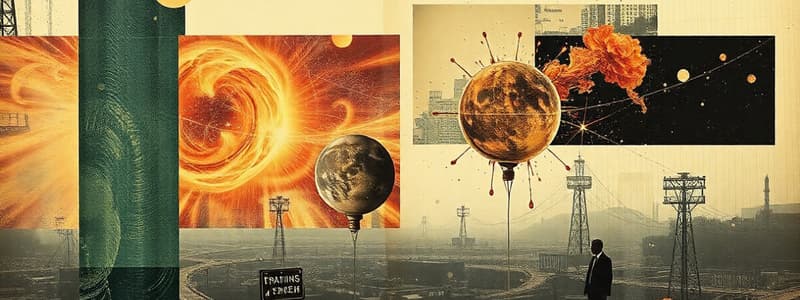Podcast
Questions and Answers
Which of the following energy conversions is NOT accurately described?
Which of the following energy conversions is NOT accurately described?
- Solar cells: Light energy to electrical energy
- Burning fossil fuels: Chemical energy to thermal energy and mechanical energy
- Nuclear power: Nuclear energy to thermal energy to mechanical energy to chemical energy (correct)
- Hydroelectric power: Potential energy of water to kinetic energy to electrical energy
In a hydroelectric dam system, the process of converting energy can be described as:
In a hydroelectric dam system, the process of converting energy can be described as:
- Potential energy to electrical energy to kinetic energy
- Electrical energy to potential energy to kinetic energy
- Potential energy to kinetic energy to electrical energy (correct)
- Kinetic energy to potential energy to electrical energy
Consider a car traveling down a road. Which type of energy conversion is primarily at work?
Consider a car traveling down a road. Which type of energy conversion is primarily at work?
- Kinetic energy to potential energy
- Electrical energy to mechanical energy
- Chemical energy to electrical energy
- Potential energy to kinetic energy (correct)
Which of the following scenarios BEST illustrates the conversion of light energy to thermal energy?
Which of the following scenarios BEST illustrates the conversion of light energy to thermal energy?
A wind turbine harnesses the kinetic energy of the wind to generate electricity. What is the initial energy source for the wind's motion?
A wind turbine harnesses the kinetic energy of the wind to generate electricity. What is the initial energy source for the wind's motion?
Which energy transfer process involves the movement of fluids?
Which energy transfer process involves the movement of fluids?
What type of energy transfer occurs when a hot pan directly heats a piece of meat?
What type of energy transfer occurs when a hot pan directly heats a piece of meat?
Which energy transfer process does not need a medium to occur?
Which energy transfer process does not need a medium to occur?
How does a microwave oven use energy transfer to heat food?
How does a microwave oven use energy transfer to heat food?
What type of energy transfer occurs when a person pushes a box across the floor?
What type of energy transfer occurs when a person pushes a box across the floor?
How does energy transfer by convection contribute to the formation of clouds?
How does energy transfer by convection contribute to the formation of clouds?
What energy transfer process is responsible for feeling the warmth of a campfire?
What energy transfer process is responsible for feeling the warmth of a campfire?
Which of these statements is NOT an example of energy transfer?
Which of these statements is NOT an example of energy transfer?
Flashcards
Energy Sources
Energy Sources
Origins of energy used by humans, can be renewable or non-renewable.
Renewable Energy Sources
Renewable Energy Sources
Energy sources that are naturally replenished, e.g., solar, wind, hydro.
Energy Efficiency
Energy Efficiency
How effectively energy is used to achieve desired outcomes, can be improved.
Energy Consumption
Energy Consumption
Signup and view all the flashcards
Energy Sustainability
Energy Sustainability
Signup and view all the flashcards
Kinetic Energy
Kinetic Energy
Signup and view all the flashcards
Potential Energy
Potential Energy
Signup and view all the flashcards
Thermal Energy
Thermal Energy
Signup and view all the flashcards
Conduction
Conduction
Signup and view all the flashcards
Convection
Convection
Signup and view all the flashcards
Radiation
Radiation
Signup and view all the flashcards
First Law of Thermodynamics
First Law of Thermodynamics
Signup and view all the flashcards
Second Law of Thermodynamics
Second Law of Thermodynamics
Signup and view all the flashcards
Study Notes
Forms of Energy
- Energy is the capacity to do work or cause change. It exists in various forms, including:
- Kinetic energy: energy of motion. The faster an object moves, the more kinetic energy it possesses.
- Potential energy: stored energy due to position or configuration. Examples include gravitational potential energy (due to height) and elastic potential energy (due to stretching or compressing).
- Thermal energy: energy associated with the temperature of an object or system. Higher temperatures correspond to greater thermal energy.
- Light energy: electromagnetic radiation that can be seen by the human eye.
- Chemical energy: energy stored within the bonds of chemical compounds.
- Nuclear energy: energy released by changes in the nucleus of an atom.
Energy Transfer Processes
- Energy can be transferred from one object or system to another in various ways:
- Conduction: the transfer of thermal energy through direct contact between objects. Heat flows from hotter to colder objects.
- Convection: the transfer of thermal energy through the movement of fluids (liquids or gases). Warmer, less dense fluids rise, while cooler, denser fluids sink.
- Radiation: the transfer of energy through electromagnetic waves. This process does not require a medium, such as conduction or convection. Examples include heat from a fire or light from the sun.
- Work: a transfer of energy that occurs when a force acts upon an object and causes it to move. The amount of work done is equal to the force applied multiplied by the distance moved in the direction of the force.
- Heat: the transfer of thermal energy from one object to another due to a temperature difference.
Laws of Thermodynamics
- Thermodynamics describes the relationship between heat, work, and energy. Key principles include:
- First Law of Thermodynamics: Energy cannot be created or destroyed, only transformed from one form to another. The total energy of an isolated system remains constant.
- Second Law of Thermodynamics: The entropy (disorder) of an isolated system can only increase over time. Heat energy will naturally flow from a hotter to a colder object.
- Third Law of Thermodynamics: As the temperature of a system approaches absolute zero, the entropy approaches a constant minimum value.
Energy Conversion
- Energy conversion is the process of changing energy from one form to another. Examples include:
- Burning fossil fuels (chemical energy to thermal energy and mechanical energy)
- Hydroelectric power (potential energy of water to kinetic energy to electrical energy)
- Solar cells (light energy to electrical energy)
- Nuclear power (nuclear energy to thermal energy to mechanical energy to electrical energy).
Energy Sources
- Energy sources are the origins of energy used by humans. These sources can be:
- Renewable energy sources: naturally replenished, e.g., solar, wind, hydro, geothermal, biomass.
- Non-renewable energy sources: finite reserves, e.g., fossil fuels (coal, oil, natural gas), nuclear fission.
Energy Efficiency
- Energy efficiency describes how effectively energy is used to achieve a desired outcome. Strategies to improve efficiency include:
- Insulation in buildings to reduce heat loss.
- Energy-efficient appliances and lighting.
- Improved vehicle designs and driving habits.
- Optimizing industrial processes.
Energy Consumption
- Energy consumption reflects the amount of energy used by individuals, communities, and nations. Factors influencing consumption include:
- Population size.
- Economic activity.
- Technological advancements.
- Lifestyle choices.
Energy Storage
- Energy storage is crucial for utilizing intermittent energy sources. Methods include:
- Batteries
- Pumped hydro storage.
- Thermal storage.
- Compressed air energy storage.
- Other emerging technologies.
Energy Sustainability
- Energy sustainability focuses on meeting current energy needs while preserving resources for future generations. Key aspects include:
- Reduced reliance on fossil fuels.
- Increased use of renewable energy sources.
- Improved energy efficiency.
- Responsible energy management practices.
Studying That Suits You
Use AI to generate personalized quizzes and flashcards to suit your learning preferences.




